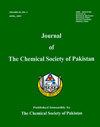棉籽油中农药残留分析方法的建立与验证
IF 0.5
4区 化学
Q4 CHEMISTRY, MULTIDISCIPLINARY
Journal of the chemical society of pakistan
Pub Date : 2022-01-01
DOI:10.52568/000996/jcsp/44.02.2022
引用次数: 0
摘要
本研究报道了一种快速、高效、经济的多残留方法,用于测定棉籽油中14种亲脂性农药和分析上存在问题的农药。棉籽油中含有大量的饱和脂肪酸和色素,在农药残留分析中存在问题。采用乙腈与正己烷以10:1 (v/v)比的改进液液分配法提取农药。采用不同的吸附剂组合进行清理,活性炭与伯仲胺组合对所选农药的回收率最佳,基质效应最小。多数农药的回收率(71.6 ~ 140.0%)、精密度(%RSD 9.7 ~ 33.0)、检出限(0.041 ~ 0.096、181 g/g)、定量限(0.125 ~ 0.264、181 g/g)、线性度(0.998 ~ 0.999)、基质效应(177 ~ 27%)均符合欧盟SANTE标准。实验室间比较研究的双向方差分析显示,所研究的大多数农药的交互效应不显著,表明本方法可以在实验室中可靠地用于原棉籽油中农药的监测。本文章由计算机程序翻译,如有差异,请以英文原文为准。
Development and Validation of an Analytical Method for Pesticide Residues Analysis in Crude Cottonseed Oil
This study reports the development and validation of a fast, efficient, and cost effective multiresidue method for determination of 14 lipophilic and analytically problematic pesticides in crude cottonseed oil. Crude cottonseed oil contains high amount of saturated fatty acid and pigments that are problematic in pesticide residues analysis. Modified liquid-liquid partitioning with acetonitrile and n-hexane in 10:1 (v/v) ratio was used to extract pesticides. For clean-up, different combinations of sorbents were used and optimum recovery and minimal matrix effect were obtained with the combination of activated charcoal and primary secondary amine for the selected pesticides. For majority of the analyzed pesticides, the method validation parameters i.e. percent recovery (71.6-140.0%), precision (%RSD 9.7 to 33.0), LOD (0.041 to 0.096 and#181;g/g), LOQ (0.125-0.264 and#181;g/g), linearity (0.998-0.999) and matrix effect (and#177;27%) were in acceptable range as prescribed by EU SANTE guidelines. Two-way Analysis of variance of inter-labs comparison study revealed non-significant interaction effects for most of studied pesticides indicating that the current method can be confidently used in labs for monitoring of these pesticides in crude cottonseed oil.
求助全文
通过发布文献求助,成功后即可免费获取论文全文。
去求助
来源期刊
CiteScore
1.30
自引率
14.30%
发文量
41
审稿时长
3.4 months
期刊介绍:
This journal covers different research areas in the field of Chemistry. These include; Analytical Chemistry, Applied Chemistry, Biochemistry, Environmental Chemistry, Industrial Chemistry, Inorganic Chemistry, Organic Chemistry and Physical Chemistry. The journal publishes full length articles and Reviews from researchers in academia in addition to featuring comments. Chemical Research presents short, concise and critical articles offering easy-to-read overviews of basic research and applications in all areas of chemistry.

 求助内容:
求助内容: 应助结果提醒方式:
应助结果提醒方式:


